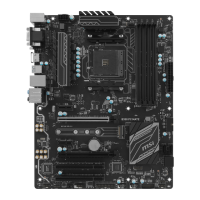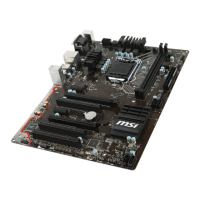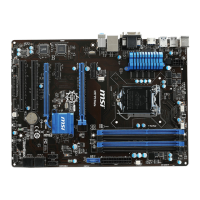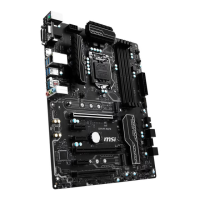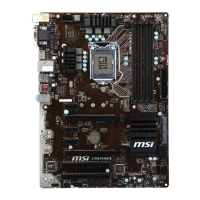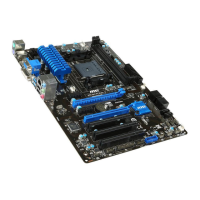Do you have a question about the MSI B85-G41 PC Mate and is the answer not in the manual?
Legal notice regarding document content and product changes.
Lists registered trademarks of various companies used in the manual.
Records revisions made to the manual with dates.
Describes MSI's smart web gadget for IT buyers and product comparisons.
Provides contact information and resources for technical assistance and troubleshooting.
Crucial guidelines for safe operation and handling of the equipment to prevent damage or injury.
Statement on compliance with FCC rules for digital devices and radio frequency interference.
Declaration of compliance with essential safety requirements of relevant European Directives.
Details compliance with FCC radiation exposure limits for uncontrolled environments.
States compliance with RF Exposure Requirement and R&TTE Directive.
Wireless equipment warnings and regulations specific to Taiwan.
Statement on compliance with Japan's VCCI Class B standards for information technology equipment.
Warning statements regarding radio wave interference for Korean users.
Guidelines for proper disposal and recycling of batteries according to regional regulations.
Information regarding chemical substances in products as per EU REACH Regulation.
Information on the disposal of electronic waste according to EU directive.
Lists the requirements and supported operating systems for Intel SBA.
Step-by-step instructions for installing the Intel SBA software.
Configuration of password and security questions for Intel SBA.
Location and function of the help button in the Intel SBA interface.
Introduces Intel RAID controller features and RAID levels supported.
How to use the Intel Rapid Storage Technology Option ROM for RAID management.
Procedures for creating, deleting, and resetting RAID volumes.
Instructions for deleting a RAID volume and its associated data.
Procedure to remove RAID structures and revert disks to non-RAID status.
Configures recovery volume modes for data redundancy.
Explains how to handle degraded RAID arrays and rebuild them.
Enables system acceleration using an SSD as a cache with Intel Rapid Storage Technology.
Manually synchronizes data between hard disk and SSD cache in Maximized acceleration mode.
Lists the items included in the motherboard package.
Lists optional accessories that can be purchased separately.
Crucial safety and handling instructions for assembling computer components.
Detailed technical specifications of the motherboard, including CPU, chipset, memory, etc.
Details the connectors and ports available on the motherboard's back panel.
Describes the internal connectors on the motherboard for various components.
Identifies the I/O controller chip used on the motherboard.
Features related to monitoring system hardware like temperature and fan speeds.
Lists key BIOS features and capabilities of the motherboard.
Highlights unique or special features of the motherboard.
Information about drivers and utilities provided on the driver disc for system optimization.
Specifies the physical dimensions and form factor of the motherboard.
Visual guide showing the location of various connectors on the motherboard.
Detailed reference for motherboard connectors, including port name, type, and page number.
Visual guide to the ports and connectors on the motherboard's back panel.
Details the standard RJ-45 LAN jack for network connectivity.
Explains the audio connectors and their functions based on color coding.
Describes the physical characteristics of the LGA 1150 CPU for proper alignment.
Step-by-step guide for installing the CPU and its heatsink correctly.
Explains the correct placement of memory modules for Dual-Channel mode.
Instructions and diagrams for correctly mounting the motherboard in the computer case.
Details the ATX power connectors on the motherboard and how to connect them.
Describes the PCIe expansion slots and their specifications.
Describes the older PCI expansion slots and their specifications.
Step-by-step instructions for installing a single graphics card.
Explains how to set up and use AMD CrossFire for multi-GPU performance.
Explains the SATA connectors for connecting storage devices like HDDs and SSDs.
Describes the fan power connectors for system cooling fans.
Explains how to connect front panel switches and LEDs using JFP1 and JFP2 connectors.
Details the USB 2.0 expansion connectors for peripherals.
Details the USB 3.0 expansion connector for high-speed peripherals.
Describes the chassis intrusion connector for security monitoring.
Explains the front panel audio connector for audio devices.
Details the connector for a Trusted Platform Module (TPM).
Describes the serial port connector for attaching serial devices.
Explains the parallel port connector for printers and other parallel devices.
Instructions for using the Clear CMOS jumper to reset BIOS settings.
Instructions for using the Total Installer utility to install drivers and software.
Step-by-step visual guide for installing the CPU.
Step-by-step visual guide for installing memory modules.
Visual guide for installing the motherboard into the computer case.
Visual guide for connecting power connectors to the motherboard.
Step-by-step guide for installing SATA Hard Disk Drives.
Step-by-step guide for installing mSATA Solid State Drives.
Instructions for connecting front panel connectors and audio.
Guide for installing USB 2.0 and USB 3.0 connectors.
Visual guide for installing graphics cards into expansion slots.
How to access and enter the BIOS setup utility.
Methods for entering the BIOS setup from the operating system or during boot.
Overview of the BIOS interface and its main sections.
Explanation of hotkeys and mouse operations for navigating BIOS settings.
Displays system date, time, and SATA device information.
Allows setting the system time and date.
Shows information about connected SATA devices.
Displays detailed system information like CPU, BIOS version, and memory.
Configuration options for advanced system settings like PCI, ACPI, and peripherals.
Sets the operating mode for onboard SATA controllers (IDE, AHCI, RAID).
Adjusts settings for the integrated graphics processor.
Configures Intel Rapid Start Technology for faster system resume.
Manages onboard USB controller and device functions.
Configures Super IO chip parameters for COM and LPT ports.
Configures system power management settings like EuP 2013 and AC power loss behavior.
Enables or disables MSI Fast Boot for faster system boot times.
Configures Windows secure boot to prevent unauthorized access.
Configures system wake-up behaviors for different sleep modes.
Configures system boot sequence and boot mode options.
Manages system security features like passwords and U-Key.
Options for saving changes, discarding changes, and exiting BIOS setup.
Displays current CPU, memory, and ring frequencies.
Selects the operating mode for CPU ratio.
Enables or disables Intel Turbo Boost technology.
Configures XMP profiles for memory overclocking.
Advanced settings for DRAM timing and configuration.
Selects control modes for CPU, Ring, and GT voltages.
Configures VR voltage and current protection settings.
Manages spread spectrum feature to reduce EMI and its effect on overclocking.
Configuration options for CPU features like Hyper-Threading and virtualization.
Manages adaptive thermal monitor to protect CPU from overheating.
Configures Intel C-States for processor power management.
Sets CPU ratios for turbo boost mode based on active cores.
Enables or disables booting from a USB flash disk with a BIOS file.
| Form Factor | ATX |
|---|---|
| Socket | LGA 1150 |
| Chipset | Intel B85 |
| Memory Slots | 4 |
| Max Memory | 32 GB |
| Memory Standard | DDR3 1600/ 1333/ 1066 MHz |
| PCI Express x16 | 1 |
| PCI Express x1 | 2 |
| PCIe 2.0 x16 Slots | 1 |
| PCI Slots | 2 |
| SATA 6Gb/s | 4 |
| SATA 3Gb/s | 2 |
| USB 3.0 Ports | 2 (rear) + 2 (front) |
| USB 2.0 Ports | 6 |
| LAN | 1 x Gigabit LAN |
| Audio | Realtek ALC887, 7.1-Channel High Definition Audio |
| RAID Support | RAID 0, 1, 5, 10 |
